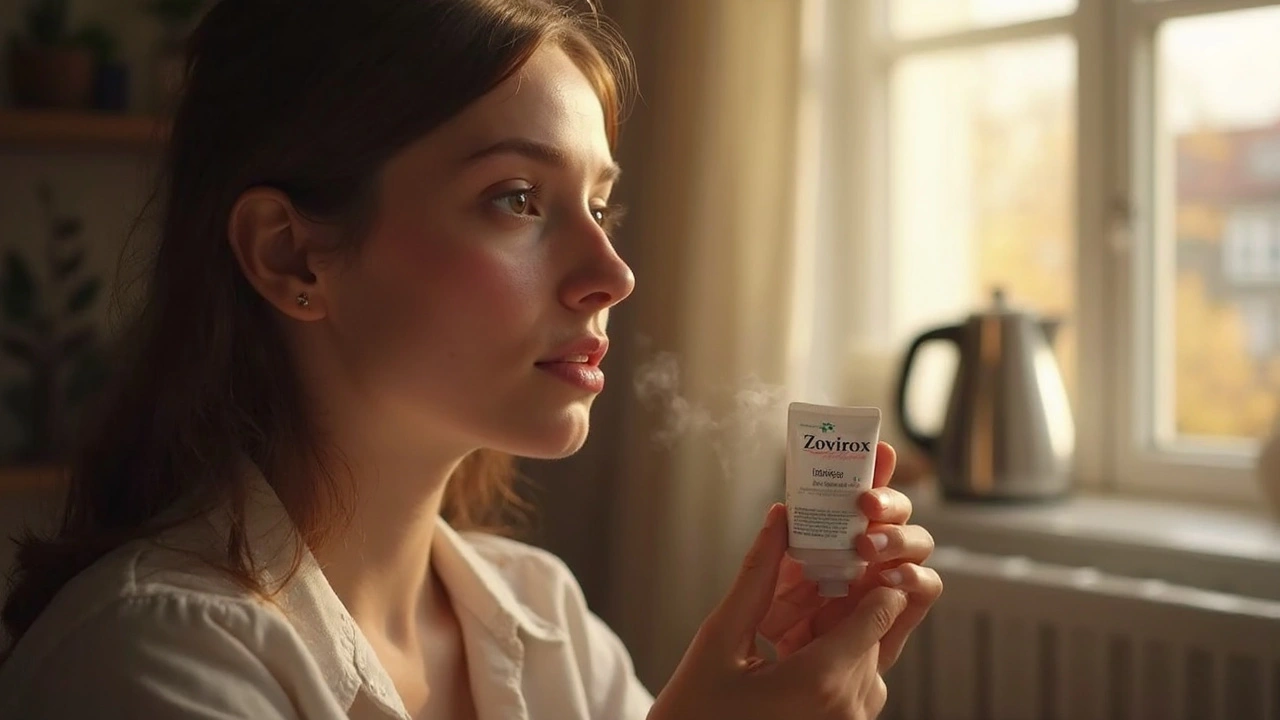Ever had a cold sore show up right before a big date, an adventurous weekend, or an important work presentation? You’re definitely not alone. That tingling, burning, then outright painful patch on your lip is all too familiar to millions, with about 67% of the global population under 50 carrying the herpes simplex virus type 1 (HSV-1) that causes these unforgettable facial flares. So, it’s no shock that people are on the hunt for something that will make those unwelcome visitors disappear faster—and that’s where zovirax comes in. But what actually makes this little tube of cream or patch of pills work? Let’s break down why Zovirax is still a must-have in bathroom cabinets from Melbourne to Montreal and what you can do to make the most of its virus-fighting power.
How Zovirax Works: The Science Behind the Cream and Pills
Zovirax, known by its generic name acyclovir, isn’t just another over-the-counter fix you hope will do away with your cold sore before your next Zoom call. Originally developed in the 1970s, it works by targeting herpes simplex viruses at their core. Viruses are sneaky—unlike bacteria, they need to hijack your body’s cells to multiply. Acyclovir steps in and acts as a roadblock by mimicking one of the building blocks (nucleotides) that the virus needs to copy itself. Once acyclovir gets into a cell infected by herpes simplex, the virus tries to use it, but it just grinds the whole system to a halt. This slows down the virus, making cold sores heal faster and reducing how long they’re contagious.
One thing most people don’t know: Zovirax only targets cells infected by the virus, so healthy skin cells are mostly left alone. This selectivity means side effects are usually minor—think a bit of burning or stinging at the application site, or maybe a mild headache or stomach upset if you’re taking it in pill form. Zovirax is especially good for people who get recurring outbreaks. For those who end up with cold sores more than six times a year, doctors sometimes suggest a low daily dose to keep the virus in check. The trick is catching the sore at the absolute first sign—a tingling, itchy feeling—before it erupts. Waiting until blisters show makes Zovirax less spectacular, though it still shaves a couple days off the healing window.
People sometimes mix up Zovirax with antibiotics or think it’ll wipe out every skin virus. Not true—antibiotics do nada against viruses, and Zovirax is specialized for herpes family viruses. If you’re tackling shingles (herpes zoster), genital herpes (HSV-2), or even chickenpox, your doctor might reach for acyclovir but will prescribe it in different doses or forms. That’s why the advice floating round the internet about using someone else’s Zovirax cream isn’t just unsanitary—it can also be plain ineffective.
| Condition | Dosage Form | Typical Dosage | Duration |
|---|---|---|---|
| Cold sores (HSV-1) | Cream (topical) | 5 times daily | 5 days |
| Genital herpes (HSV-2) | Tablet | 200mg 5 times daily | 5-10 days |
| Shingles (herpes zoster) | Tablet | 800mg 5 times daily | 7 days |
Fun fact: When taken early enough, Zovirax shortens the average duration of a cold sore episode from about 10 days to 7—sometimes even less if you’re quick on the draw. That’s three less days of covering your mouth in Zoom calls or avoiding cheek kisses from family.
Who Should Use Zovirax and When Does It Actually Help?
Not everyone with a cold sore needs to rush to the chemist for a prescription. Most cold sores clear up by themselves, but if you prefer to heal faster, have a big event coming up, or your outbreaks get nastier than most, Zovirax is worth considering. It works best for folks who catch their outbreak super early. Waiting until a blister is full-blown and crusty means you’ve missed the ideal window. The good news? Even at later stages, you might still benefit, especially if you tend to heal slowly, have immune problems, or get severe pain.
Zovirax also plays a huge role for people who are immunocompromised. For instance, cancer patients, transplant recipients, or anyone on strong immune-suppressing medication often get prescribed acyclovir to stop herpes viruses from taking over. Pregnant women sometimes need special advice here—most doctors in Australia agree Zovirax cream is usually safe during pregnancy and breastfeeding, but it’s always best to double-check with your GP or pharmacist before starting anything new. Kids over 12 months can also use topical Zovirax in most cases, which is a lifesaver for frazzled parents dealing with a sore-lipped toddler who likes to share drinks and kisses.
If you’re using contact lenses, keep Zovirax far from your eyes—herpetic eye infections are a different beast and need special ophthalmic treatment. Some folks try using the cream inside their nose for cold sores, but the nose lining is sensitive and absorbs cream in unpredictable ways. Better to stick with what the packet says and only put on cold sores that are actually on your lips or face. And never use it on broken or bleeding skin—let things settle down a bit before applying.
Here’s a handy expert tip: Always wash your hands before and after putting on Zovirax, and don’t double-dip into the same tube if you’re treating multiple sores—use a cotton swab or clean finger to avoid spreading the virus. Don’t share tubes or creams, even with family members. And if you’re someone who deals with a lot of sun, wind, or activities like skiing (yep, Melbourne gets cold enough), these can all trigger cold sores—so keep a tube handy in your kit or car, just in case.
For people with cold sore triggers like stress or illness, it might be worth taking Zovirax preventatively before those situations. For instance, if you always get a breakout after a bad cold or before exams, try a quick check-in with your pharmacist or doctor about a short course. There’s also evidence that combining Zovirax with other strategies—hydration, lip balm, and plenty of rest—can make a real difference in beating the virus before it beats you.

Side Effects, Myths, and What People Get Wrong About Zovirax
So, does Zovirax come with some baggage? The side effects are usually mild, with most people only reporting a little local irritation or a metallic taste in the mouth (if taken orally). Rarely, someone might get a rash or feel dizzy. If you’re allergic to acyclovir or its cream base, steer clear. There’s a persistent myth that using Zovirax could make your cold sores resistant and turn into superbugs, but that’s not how herpes viruses work. Resistance can occur but is mainly an issue for very immunocompromised people getting years of treatment—not your average person treating the occasional facial cold sore.
Here’s the other myth floating around: You can use Zovirax cream for any skin rash. Nope. It’s not going to do anything against things like eczema, pimples, or insect bites. It’s specialized for herpes viruses. You’d be surprised how many people, even in this age of Dr. Google, try medicating a suspicious spot with acyclovir cream and expect miracles. Best save it for official cold sores or a clear herpes diagnosis by a GP—don’t waste medicine and money.
Some folks also get tripped up mixing oral (tablet) and topical (cream) versions at the same time. It’s not dangerous, but unless directed by a doctor, doubling up isn’t necessary. Studies done at the Royal Melbourne Hospital have shown that for most people with normal immune systems, using one or the other does the trick. Always follow dose instructions—slathering on half a tube at once won’t make your sore disappear and could just irritate your skin more.
A lot of people ask about using Zovirax with other cold sore home remedies. You can use things like cold compresses, petroleum jelly, or aloe vera as long as you let Zovirax soak in first. Don’t combine it with other medicated creams unless a doctor says it’s okay. Also, don’t use Zovirax beyond the expiry date or leave it somewhere hot (like a glove box in the summer)—heat can make it less potent, and you’ll be left wondering why your trusty cream isn’t working anymore.
One overlooked tip? If you keep getting cold sores on your chin or corners of your mouth from shaving (yep, even guys and husky owners like me aren’t immune), consider switching razors more often and applying Zovirax right after any nicks or cuts, before the virus grabs its chance.
Making the Most of Your Zovirax: Tips for Faster Healing and Fewer Outbreaks
Want to shave days off that cold sore drama? Timing is everything. The moment you get a weird tingle, reach for your Zovirax cream and apply a thin layer—the best results happen within the first 12 hours. Don’t pile it on—skin won’t absorb extra, and you’re just wasting good cream. Wash your hands first to avoid spreading the virus to your nose, eyes, or other people (my Husky Aurora once got a swipe on the nose from my absent-minded hand, and that was a vet trip I do not want to repeat).
- Use a mirror to get precise application.
- Let the cream dry before adding lip balm or sunscreen.
- Carry a small Zovirax tube for emergencies—some have keychain-sized packs now.
- Consider a prescription for Zovirax tablets if you get severe outbreaks or are traveling where creams aren’t available.
- Don’t touch or pick at your cold sore—you risk spreading the virus to other parts of your face.
- Switch out toothbrushes and razors after every outbreak to avoid reinfection.
- Use a separate towel for your face and don’t share with others during an outbreak.
Some cold sore veterans keep a ‘survival kit’ ready, which includes Zovirax, a good SPF lip balm (sun is a huge trigger in Australia’s climate!), tissues, and a gentle moisturizer. Stress is a cold sore’s best friend, so doing what you can to relax—in my case, a good run with Aurora—could lower your risk, too.
Another underused tip: If you get outbreaks during big events (like weddings or trips), ask your doctor if a preventive course is right for you. Acyclovir can be used strategically, just a few days before a known trigger, to keep lips clear. Just don’t overuse—taking it when you don’t need to can make future outbreaks tougher to deal with.
For persistent pains, see your GP—sometimes what looks like a cold sore isn’t, and you might need a lab test to confirm. And if Zovirax doesn’t seem to work anymore, your doctor can switch you to another antiviral, like famciclovir or valacyclovir—sometimes the virus will get sneaky, but science is sneakier.
So next time a cold sore threatens to ruin your plans, you’re not stuck with just hope and a scarf. With Zovirax in your first aid kit and a bit of know-how, you can get back to work, play, or that long walk on the Yarra with your pups—minus the embarrassing lip drama. Just remember, speed, hygiene, and the right sum of old-school common sense make all the difference between a quick recovery and a two-week ordeal.



Calvin Smith
Oh, Zovirax? The old antiviral champ of the cold sore world! Honestly, I’ve never been wild about these drugs but hey, sometimes you gotta play the game. The way it works, blocking the virus’s ability to multiply, makes some sort of sense, but I’ve seen folks swear by home remedies too.
What bothers me though is the myth that you gotta catch it right at the tingle stage or you’re doomed. Like, come on, who has the psychic ability to always spot that crap? Anyway, if Zovirax actually speeds things up, I’m all ears, but still, feels like pharma magic mixed with a bit of placebo.
Anyone else here skeptical of the whole antivirals-for-everything trend or am I just the conspiracy guy in the room?